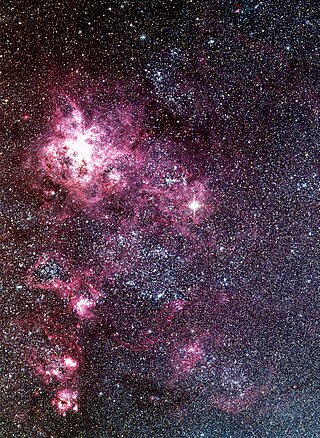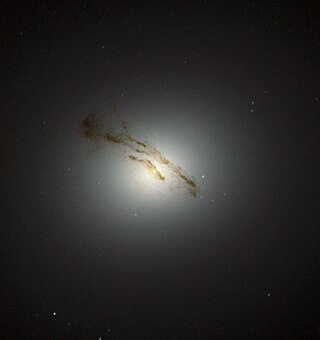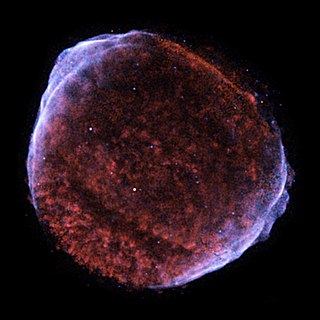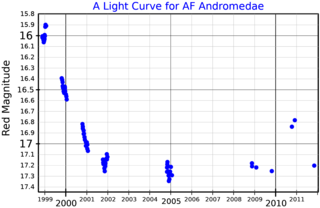
A supernova is a powerful and luminous explosion of a star. A supernova occurs during the last evolutionary stages of a massive star or when a white dwarf is triggered into runaway nuclear fusion. The original object, called the progenitor, either collapses to a neutron star or black hole, or is completely destroyed to form a diffuse nebula. The peak optical luminosity of a supernova can be comparable to that of an entire galaxy before fading over several weeks or months.

SN 1987A was a type II supernova in the Large Magellanic Cloud, a dwarf satellite galaxy of the Milky Way. It occurred approximately 51.4 kiloparsecs from Earth and was the closest observed supernova since Kepler's Supernova. 1987A's light reached Earth on February 23, 1987, and as the earliest supernova discovered that year, was labeled "1987A". Its brightness peaked in May, with an apparent magnitude of about 3.

SN 1604, also known as Kepler's Supernova, Kepler's Nova or Kepler's Star, was a Type Ia supernova that occurred in the Milky Way, in the constellation Ophiuchus. Appearing in 1604, it is the most recent supernova in the Milky Way galaxy to have been unquestionably observed by the naked eye, occurring no farther than 6 kiloparsecs from Earth. Before the adoption of the current naming system for supernovae, it was named for Johannes Kepler, the German astronomer who described it in De Stella Nova.
Timeline of neutron stars, pulsars, supernovae, and white dwarfs

The Crab Nebula is a supernova remnant and pulsar wind nebula in the constellation of Taurus. The common name comes from a drawing of the object produced by William Parsons, 3rd Earl of Rosse, in 1842 or 1843 using a 36-inch (91 cm) telescope that somewhat resembled a crab with arms. The nebula was discovered by English astronomer John Bevis in 1731. It corresponds with a bright supernova recorded by Chinese astronomers in 1054 as a guest star. The nebula was the first astronomical object identified that corresponds with a historically-observed supernova explosion.

Carl Ernst Albrecht Hartwig was a German astronomer.

Messier 84 or M84, also known as NGC 4374, is a giant elliptical or lenticular galaxy in the constellation Virgo. Charles Messier discovered the object in 1781 in a systematic search for "nebulous objects" in the night sky. It is the 84th object in the Messier Catalogue and in the heavily populated core of the Virgo Cluster of galaxies, part of the local supercluster.

First observed between August 4 and August 6, 1181, Chinese and Japanese astronomers recorded the supernova now known as SN 1181 in eight separate texts. One of only nine supernovae in the Milky Way observable with the naked eye in recorded history, it appeared in the constellation Cassiopeia and was visible in the night sky for about 185 days.

SN 1006 was a supernova that is likely the brightest observed stellar event in recorded history, reaching an estimated −7.5 visual magnitude, and exceeding roughly sixteen times the brightness of Venus. Appearing between April 30 and May 1, 1006, in the constellation of Lupus, this "guest star" was described by observers across China, Japan, modern-day Iraq, Egypt, and Europe, and was possibly recorded in North American petroglyphs. Some reports state it was clearly visible in the daytime. Modern astronomers now consider its distance from Earth to be about 7,200 light-years or 2,200 parsecs.

Luminous blue variables (LBVs) are massive evolved stars that show unpredictable and sometimes dramatic variations in their spectra and brightness. They are also known as S Doradus variables after S Doradus, one of the brightest stars of the Large Magellanic Cloud. They are extraordinarily rare, with just 20 objects listed in the General Catalogue of Variable Stars as SDor, and a number of these are no longer considered LBVs.

A Type Ia supernova is a type of supernova that occurs in binary systems in which one of the stars is a white dwarf. The other star can be anything from a giant star to an even smaller white dwarf.

NGC 2207 and IC 2163 are a pair of colliding spiral galaxies about 80 million light-years away in the constellation Canis Major. Both galaxies were discovered by John Herschel in 1835.

The known history of supernova observation goes back to 1006 AD. All earlier proposals for supernova observations are speculations with many alternatives.

A luminous red nova is a stellar explosion thought to be caused by the merging of two stars. They are characterised by a distinct red colour, and a light curve that fades slowly with resurgent brightness in the infrared. Luminous red novae are not related to standard novae, which are explosions that occur on the surface of white dwarf stars.

AE Andromedae is a luminous blue variable (LBV), a type of variable star. The star is one of the most luminous variables in M31, the Andromeda Galaxy.

SN 2014J was a type-Ia supernova in Messier 82 discovered in mid-January 2014. It was the closest type-Ia supernova discovered for 42 years, and no subsequent supernova has been closer as of 2023. The supernova was discovered by chance during an undergraduate teaching session at the University of London Observatory. It peaked on 31 January 2014, reaching an apparent magnitude of 10.5. SN 2014J was the subject of an intense observing campaign by professional astronomers and was bright enough to be seen by amateur astronomers.

NGC 1614 is the New General Catalogue identifier for a spiral galaxy in the equatorial constellation of Eridanus. It was discovered on December 29, 1885 by American astronomer Lewis Swift, who described it in a shorthand notation as: pretty faint, small, round, a little brighter middle. The nebula was then catalogued by Danish-Irish astronomer J. L. E. Drayer in 1888. When direct photography became available, it was noted that this galaxy displayed some conspicuous peculiarities. American astronomer Halton Arp included it in his 1966 Atlas of Peculiar Galaxies. In 1971, Swiss astronomer Fritz Zwicky described it as a "blue post-eruptive galaxy, compact patchy core, spiral plumes, long blue jet SSW".

SN 2020oi was a supernova event in the grand design spiral galaxy known as Messier 100, or NGC 4321. It was discovered January 7, 2020 at an apparent magnitude of 17.28 by F. Forster and associates using the Zwicky Transient Facility. The position places it ~4.67″ north of the galactic nucleus. The supernova was not detected on an observation made three days before the discovery, and thus it must have begun during that brief period. The light curve peaked around January 13–18, depending on the wavelength, then declined rapidly over a period of 25 days before flattening into a more gradual decline. Observations of the spectrum made with the SOAR telescope showed this to be a type Ic supernova, with the progenitor being a massive star that had its outer envelope stripped. The initial velocity of the expanding photosphere was ~15,000 km/s.

AF Andromedae is a luminous blue variable (LBV), a type of variable star. The star is one of the most luminous variables in M31, the Andromeda Galaxy.



















